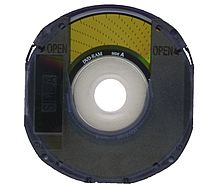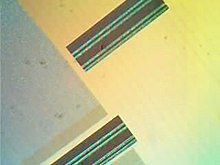DVD-RAM
This article needs additional citations for verification. (June 2013) |
| Optical discs |
|---|
DVD-RAM (DVD Random Access Memory) is a disc specification presented in 1996 by the DVD Forum, which specifies rewritable DVD-RAM media and the appropriate DVD writers. DVD-RAM media have been used in computers as well as camcorders and personal video recorders since 1998.
In May 2019, Panasonic, the only remaining manufacturer of DVD-RAM discs, announced that it would end production of DVD-RAM media by the end of that month, citing shrinking demand as the primary motivation.[1]
Design
DVD-RAM was one of three competing technologies for rewritable DVDs. Its competitors are DVD-RW and DVD+RW. DVD-RAM technology provides good data integrity, data retention and damage protection through a number of mechanisms and properties. Therefore, DVD-RAM is perceived by people (who need to store their data on DVDs for long periods of time) to be better than the other DVD technologies for traditional computer usage tasks such as general data storage, and especially data backup and archival. The Mount Rainier Format standard and SecurDisc for DVD±RW (which also works on DVD-RAM, CD-R, and CD-RW) somewhat lessens the DVD-RAM format's perceived advantage in the data integrity category, but not in the data retention or damage protection categories.
As of 2006[update], DVD-RAM had a larger presence in camcorders and set-top boxes than in computers[citation needed], although the popularity of DVD-RAM in these devices could be explained by its being very easily written to and erased, which- for example- allows extensive in-camera editing.
The on-disc structure of DVD-RAM is closely related to hard disk and floppy disk technology, as it stores data in concentric tracks. DVD-RAMs can be accessed just like a hard or floppy disk and usually without any special software. DVD-RWs and DVD+RWs, on the other hand, store data in one long spiral track and require special packet reading/writing software to read and write data discs. Like magneto-optical (MO) technologies, DVD-RAM has numerous rectangles on the disc surface that define the boundaries of data sectors. However, DVD-RAM is not MO but a phase transition medium, similar to CD-RW, DVD-RW, or DVD+RW.
Cartridge types
| Size | Bare disc | Non-removable cartridge | Removable cartridge | Empty cartridge/no disc | ||||
|---|---|---|---|---|---|---|---|---|
| sides | single | double | single | double | single | double | single | double |
| 12 cm | yes (type 0) | none | type 1 | type 1 | type 2 | type 4 | type 3 | type 5 |
| 8 cm | yes (type 0) | none | none | none | type 7 | type 6 | type 9 | type 8 |
Specification
Since the Internationale Funkausstellung Berlin 2003 the specification is being marketed by the RAM Promotion Group (RAMPRG), built by Hitachi, Toshiba, Maxell, LG Electronics, Matsushita/Panasonic, Samsung, Lite-On and Teac. The specification distinguishes between:
- DVD-RAM version 1.0, recording speed 1x
- Single-sided, one layer discs with a capacity of 2.58 GB
- Double-sided one layer discs with a capacity of 5.16 GB
- DVD-RAM version 2.0, recording speed 2x
- Single-sided, one layer discs with a capacity of 4.7 GB
- Double-sided one layer discs with a capacity of 9.4 GB
- DVD-RAM version 2.1/Revision 1.0, recording speed 3x
- DVD-RAM version 2.2/Revision 2.0, recording speed 5x
- DVD-RAM version 2.3/Revision 3.0, recording speed 6x max
- DVD-RAM version 2.4/Revision 4.0, recording speed 8x max
- DVD-RAM version 2.5/Revision 5.0, recording speed 12x max
- DVD-RAM version 2.6/Revision 6.0, recording speed 16x max
Physically smaller, 80 mm in diameter, DVD-RAM discs also exist with a capacity of 1.46 GB for a single-sided disc and 2.8 GB for a double-sided disc, but they are uncommon. DVD-RAMs were originally solely sold in cartridges; recent DVD recorders can work with discs either with or without a cartridge, and many devices do not work with cartridges. Discs can be removed from cartridges for use with these drives (except with type 1 media, see table above).
Compatibility

Many operating systems like the classic Mac OS (from Mac OS 8.6 up), macOS, Linux, and Microsoft Windows XP can use DVD-RAM directly, while earlier versions of Windows require separate device drivers or the program InCD.
Windows XP Home and Professional can only write directly to FAT32 formatted DVD-RAM discs. For UDF formatted discs, which are considered faster,[by whom?] a third-party UDF file system driver capable of writing or software such as InCD or DLA are required. Windows Vista and later can natively access and write to both FAT32 and UDF formatted DVD-RAM discs using mastered burning method or packet writing. Even though it is possible to use any file system one likes, very few perform well on DVD-RAM. This is because some file systems frequently overwrite data on the disc and the table of contents is contained at the start of the disc. Windows Vista (and later) implement the CPRM data protection and thus discs formatted under Windows XP (or earlier) have compatibility issues with Vista onwards (and vice versa).
The classic Mac OS up to 9.2 can read and write HFS, HFS+, FAT, and UDF formatted DVD-RAM discs directly. In Mac OS X (versions 10.0.x through 10.4.x) UDF-formatting of DVD-RAM is no longer supported, instead formatting and writing DVD-RAM is done in HFS+ format. (UDF support was re-implemented in 10.5 Leopard) (HFS and UFS should also be supported on older versions of Mac OS X that retain support for these file systems.)[3][4]
Many DVD standalone players and recorders do not work with DVD-RAM. However, within "RAMPRG" (the DVD-RAM Promotion Group consisting of Hitachi, Toshiba, Maxell, LG Electronics, Matsushita/Panasonic, Samsung, Lite-On, Teac) there are a number of well-known manufacturers of standalone players, recorders, and camcorders that can use DVD-RAM. Panasonic, for instance, has a range of players and recorders which make full use of the advantages of DVD-RAM.
The newest DVD-RAM Specification, DVD-RAM2 (also called RAM2), is not compatible with DVD drives that do not specifically allow reading DVD-RAM2 discs.[5]
Some high end products such as IBM System p mainframes require DVD-RAM instead of DVD-RW.[6]
Advantages



- Long life — without physical damage, data is retained for an estimated 30 years. For this reason, it is used for archival storage of data.[7][8]
- Can be rewritten over 100,000 times for the lowest write speed discs (DVD±RW can be rewritten approx. 1,000 times). Faster DVD-RAMs allow fewer rewrites (3x speed: 100,000, 5x speed: 10,000) [citation needed], but still more than DVD+RW or DVD-RW. (These are theoretical numbers. In practice they could be smaller depending on the drive, the treatment of the disc and the file system.)
- Reliable writing of discs. Verification done in hardware by the drive, so post-write verification by software is unnecessary. Software verification is disabled in all current DVD Video Recorders.
- Disc defect management designed to safeguard data.
- DVD-burning software may not be required — discs can be used and accessed like a removable hard disk. Mac OS (8.6 or later) uses DVD-RAM directly. Windows XP uses DVD-RAM directly for FAT32-formatted discs only. Windows Vista is able to write directly to both FAT32- and UDF-formatted DVD-RAM discs from within Windows Explorer. Device drivers or other software are needed for earlier versions of Windows.
- Very fast access of small files on the disc.
- Small 2 KB disc block size wastes less space when writing small files.
- Finalization not necessary. For video recording use, other media such as DVD+RW (when used in DVD+VR mode) do not require a separate finalisation either as finalisation is automatic. The table of contents can be overwritten in this latter media.
- Media available with or without protective cartridges; can be used in the cartridge by many devices.
- In some video recorders DVD-RAM can be written to and read at the same time, allowing one program to be recorded and a different one, or an earlier part of the same one (time slip recording), to be viewed at the same time. DVD+RW recorders can achieve the same thing, and more recently some DVD-RW recorders achieve it as well (though only at the slower recording speeds).
- Usable with some high-end security digital video recorders, such as the Tecton Darlex, as a secure and long-lasting export medium.
- Holds more data when using Double Sided discs than dual-layer DVD+RW and DVD-RW - 9.4GB for DVD-RAM vs 8.5GB for DVD+RW DL and DVD-RW DL.
- Has write-protect tabs to prevent accidental deletion when used in a cartridge.
Disadvantages
- High-speed media unavailability: Only 3x discs are readily available.
- Higher media cost.[citation needed]
- Less compatibility than DVD+RW and DVD-RW, despite predating both formats (as noted above).[citation needed]
See also
References
- ^ "DVD-RAM Disc for Recording Completion of Production" (in Japanese). Panasonic Corporation. Retrieved 2019-05-22.
- ^ Taylor, Jim. "DVD FAQ - What are the DVD-RAM cartridge types?". DVD Demystified. Retrieved December 15, 2019.
- ^ "Using DVD-RAM discs". support.apple.com. 2012-02-18. Retrieved 2014-02-05.
- ^ "Mac OS X: "The disc 'Ram' could not be modified" Alert". support.apple.com. 2012-02-17. Retrieved 2014-02-05.
- ^ "Usage Of 16 X DVD-RAM Disc (RAM2 Disc)". Web.archive.org. 2008-01-31. Archived from the original on 2008-01-31. Retrieved 2009-09-28.
- ^ "HMC backup". Web.archive.org. Archived from the original on 2007-02-23. Retrieved 2009-09-28.
- ^ "Fujifilm DVD-RAM Disc". Fujifilm. 2006-10-17. Archived from the original on 2006-10-17. Retrieved 2009-08-15.
- ^ "Update: Phase Change WORM". West World Productions and Gale Group. Retrieved 2007-12-29.
External links
- RAM Promotion Group (RAMPRG)
- ECMA-330 Standard
- ISO/IEC 17592:2004 - publicly available standard
- ISO/IEC 17592, 120 mm (4,7 Gbytes per side) and 80 mm (1,46 Gbytes per side) DVD rewritable disk (DVD-RAM)
- Fujitsu DVD-RAM2 compatibility note
- Understanding Recordable & Rewritable DVD


